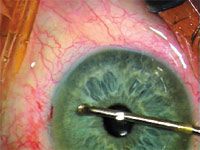Article
Surgeons describe approaches to endothelial disease
A range of corneal pathologies and their treatment-including Descemet's stripping automated endothelial keratoplasty (DSAEK), Descemet's stripping with endothelial keratoplasty (DSEK), and preventing dislocations after endothelial keratoplasty (EK)-recently has captured the interests of ophthalmologists.

Dr. Gorovoy
When performing this procedure, he uses the Moria ALTK system for the donor cut with a 300-µm head. He typically tries a 9-mm trephination punch for the donor, which can be adjusted smaller depending on the eye. The tissue is cut with the CB head of the Moria ALTK system, and Descemet's stripping is done with an irrigating stripper, he explained.
The stripper is used to score Descemet's membrane. It outlines the area of the membrane that is to be stripped.
"This is done through a 1-mm limbal paracentesis and guided by the appropriate surface trephination mark," Dr. Goro-voy said. "The current trend is to go inside the trephination mark so that bare stroma is not left, which might result in peripheral edema."
The I/A unit can be used to grab Descemet's membrane through a clear corneal incision and aspirated it from the eye.

The incision is closed, and the anterior chamber is deepened. At this point in the procedure, the tissue should unfold. If spontaneous unfolding does not occur, the surgeon can use the I/A unit to unfold it. Dr. Gorovoy injects a large air bubble under the donor tissue and allows it to remain for 1 hour, after which most of the air is released to avoid pupillary block.
"The goal is to make certain that the tissue does not impinge on the angle," he said.
The 150 cases consisted of Fuchs' dystrophy (59%) and pseudophakic post-keratopathy (28%), and the remainder consisted of failed grafts, 4% of which were primary (iatrogenic) failures, he reported.

If patients are pseudophakic and have an anterior chamber lens, he removes the lens in all cases and replaces it with a scleral-sutured lens. About 6 weeks later, he performs the DSAEK procedure, he explained.
Newsletter
Don’t miss out—get Ophthalmology Times updates on the latest clinical advancements and expert interviews, straight to your inbox.




